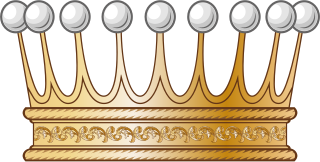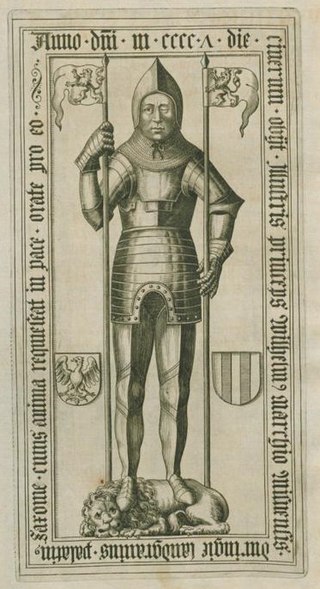
Graf is a historical title of the German nobility, usually translated as "count". Considered to be intermediate among noble ranks, the title is often treated as equivalent to the British title of "earl".

Marktbreit am Main is a town in the district of Kitzingen in the Regierungsbezirk Unterfranken in Bavaria, Germany. It is situated at the most southern point of the Main river. Marktbreit is the birthplace of Alois Alzheimer who first identified the symptoms of what is now known as Alzheimer's disease. With its suburb Gnodstadt, Marktbreit has around 3,700 inhabitants.

The House of Schönborn[ˈʃøːnbɔrn] is the name of an ancient noble and mediatised formerly sovereign family of the former Holy Roman Empire.
Castell was a county of northern Bavaria, Germany, ruling a string of territories in the historical region of Franconia, both east and west of Würzburg. Little is known about the noble Counts of Castell, although they were the counts of Kreis Gerolzhofen, Regierungsbezirk, and Unterfranken of Bavaria. They were a member of the Fränkische Grafenkolleg.

The House of Castell is a German noble family of mediatised counts of the old Holy Roman Empire. In 1901, the heads of the two family branches, Castell-Castell and Castell-Rüdenhausen, were each granted the hereditary title of Prince by Luitpold, Prince Regent of Bavaria.

Casimirof Brandenburg-Bayreuth was Margrave of Bayreuth or Margrave of Brandenburg-Kulmbach from 1515 to 1527.

Werneck is a market town in the district of Schweinfurt in Lower Franconia, Bavaria, Germany. It has a population of around 10,000 and is best known for its Baroque palace, Schloss Werneck.

Iphofen is a town in the district of Kitzingen in Bavaria, Germany. It has a population of around 4,500. Iphofen is known for its rare complete medieval town wall and other historic buildings as well as for being a location of wine production.

Rothenfels is a town in the Main-Spessart district in the Regierungsbezirk of Lower Franconia (Unterfranken) in Bavaria, Germany and a member of the Verwaltungsgemeinschaft of Marktheidenfeld. With a population of just around 1,000 it is said to be Bavaria’s smallest town.
Donatus, Prince and Landgrave of Hesse is the head of the House of Brabant and the German House of Hesse. He is the eldest son and successor of German aristocrat Moritz, Landgrave of Hesse, and his former wife, Princess Tatiana of Sayn-Wittgenstein-Berleburg. A great-grandson of Victor Emmanuel III of Italy, he is named in part after Georg Donatus, Hereditary Grand Duke of Hesse. He is also a descendant of Queen Victoria of the United Kingdom, and of Frederick III, German Emperor. He is a distant cousin of Prince Philip, Duke of Edinburgh, whose funeral he attended. The two are related through the Duke's British-born mother and a Princess of Battenberg by birth, Princess Andrew of Greece and Denmark, and the marriages of Philip’s sisters Cécilie and Sophie into the House of Hesse. Donatus also attended the state funeral of Queen Elizabeth II at Westminster Abbey, London, on 19 September 2022 with his wife, Floria.

Sigmaringen Castle was the princely castle and seat of government for the Princes of Hohenzollern-Sigmaringen. Situated in the Swabian Alb region of Baden-Württemberg, Germany, this castle dominates the skyline of the town of Sigmaringen. The castle was rebuilt following a fire in 1893, and only the towers of the earlier medieval fortress remain. Schloss Sigmaringen was a family estate of the Swabian Hohenzollern family, a cadet branch of the Hohenzollern family, from which the German Emperors and kings of Prussia came. During the closing months of World War II, Schloss Sigmaringen was briefly the seat of the Vichy French Government after France was liberated by the Allies. The castle and museums may be visited throughout the year, but only on guided tours. It is still owned by the Hohenzollern-Sigmaringen family, although they no longer reside there.

The Prince-Bishopric of Bamberg was an ecclesiastical State of the Holy Roman Empire. It goes back to the Roman Catholic Diocese of Bamberg established at the 1007 synod in Frankfurt, at the behest of King Henry II to further expand the spread of Christianity in the Franconian lands. The bishops obtained the status of Imperial immediacy about 1245 and ruled their estates as Prince-bishops until they were subsumed to the Electorate of Bavaria in the course of the German Mediatisation in 1802.

The Steigerwald is a hill region up to 498.5 m above sea level (NHN) in the Bavarian-Franconian part of the South German Scarplands between Würzburg and Nuremberg. It is part of the Keuper Uplands, and within it, it is continued to the north-northeast and right of the river Main, by the Haßberge, and to the south-southwest by the Franconian Heights. Part of the region is a designated as the Steigerwald Nature Park.

William I, the one-eyed, was Margrave of Meissen. His nickname is related to the legend that Saint Benno appeared to him because of his disputes with the Church in a dream and he had an eye gouged out.

Heiligenberg Castle is a princely castle in renaissance style, situated in Heiligenberg, Linzgau within the state of Baden-Württemberg, Germany. It is sited on a plateau 730 metres above sea level and with views down into the Bodensee and the Alps. It contains one of the most well preserved renaissance halls north of the Alps. The castle is owned and lived in by the Fürstenberg family, and cannot be visited.

The Untermainkreis was one of the administrative districts of the Kingdom of Bavaria between 1806 and 1837 named after its main river Main. It was the predecessor of the administrative district of Lower Franconia. Administrative headquarters were in Würzburg.

Wolfgang Dietrich of Castell-Remlingen was a German nobleman. From 1668 until his death he was the ruler of the county of Castell-Remlingen, sharing power with his brother Friedrich Magnus of Castell-Remlingen. He also held other offices in the Margraviate of Ansbach and the Electoral Palatinate.

The House of Faber-Castell, originating from Stein near Nuremberg, Germany, is the name of an entrepreneurial noble family, morganatic branch of the House of Castell-Rüdenhausen, which founded the Faber-Castell AG in 1761 and the Nürnberger Versicherung in 1884. A.W. Faber, the original name of the company, is the oldest company brand in the USA.


























